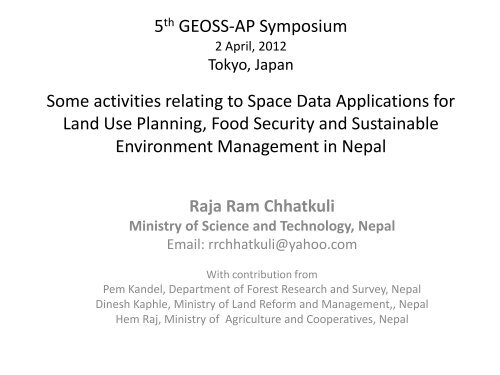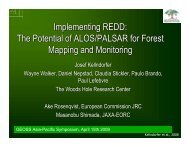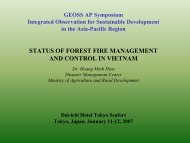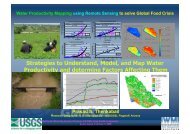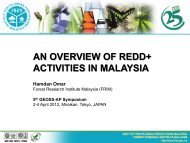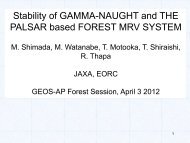APRSAF-15 9 December 2008 Hanoi, Vietnam Nepal Country Report
APRSAF-15 9 December 2008 Hanoi, Vietnam Nepal Country Report
APRSAF-15 9 December 2008 Hanoi, Vietnam Nepal Country Report
You also want an ePaper? Increase the reach of your titles
YUMPU automatically turns print PDFs into web optimized ePapers that Google loves.
5 th GEOSS-AP Symposium2 April, 2012Tokyo, JapanSome activities relating to Space Data Applications forLand Use Planning, Food Security and SustainableEnvironment Management in <strong>Nepal</strong>Raja Ram ChhatkuliMinistry of Science and Technology, <strong>Nepal</strong>Email: rrchhatkuli@yahoo.comWith contribution fromPem Kandel, Department of Forest Research and Survey, <strong>Nepal</strong>Dinesh Kaphle, Ministry of Land Reform and Management,, <strong>Nepal</strong>Hem Raj, Ministry of Agriculture and Cooperatives, <strong>Nepal</strong>
<strong>Country</strong> Profile• Situated in South Asia• Area 147181 sqkm• Population 26.8 Million• Altitutude 68m to 8848m• 80% High Himalayas and mountains areas• 20% terai plains area• Total forest cover continuously declining: currentestimate less than 40%• Himalayan region of <strong>Nepal</strong> one of the world’s top20 global biodiversity hot-spots
GDP (PPP) per capita USD 1,328 (IMF 2011)1/3 rd of GDP based on Agriculture Sector2/3 rd of the population engaged in AgriculturePercentage of population below poverty line1995-96 (WB/CBS Living Standard Survey): 41.2%2003-04 (WB/CBS Living Standard Survey): 30.9%2010-11 (WB/CBS Living Standard Survey ): 25.2%
The Millennium Development Goals1 Eradicate extreme poverty and hunger2 Achieve universal primary education3 Promote gender equality and empower women4 Reduce child mortality5 Improve maternal health6 Combat HIV/AIDS, malaria and other diseases7 Ensure environmental sustainability8 Develop a global partnership for development
Space data application for poverty reduction and foodsecurity; and Sustainable Environment• Land Use Planning (MOLRM)• NEKSAP (<strong>Nepal</strong> Khadya Surakshya Anugaman Pranalior <strong>Nepal</strong> Food Security Monitoring System (MOAC)• Forest Resource Assessment Programme(MOF/DoFRS)• Conclusion: MOST What ??
Land Use PlanningNational Land Use PolicyLand use Data AcquisitionLand Use ZoningRegularization (niyaman)
Haphazard Land development and Encroachment onPublic Land2006 2010
Example of land Use Change in ThimiSource: Janak Raj Joshi
Stake holders consultationsThe Districts Visited For Data Collection for Land Use Policy FormulationNDARC HULAHUM LABAJ HAN GBAITAD IBAJ UR AMUGUDADELDH UR ADOTIKALIKOTJUM LADOLPAAC CH AMKAN CH AN PUR DAILEKH JAJAR KOTMUST AN GKAILALISU RKH ETRUKU MMANANGBAR DIAs+rgk'/8f]6Lsflnsf]6d'u'af“s]bf·BAN KESALYAN/f]Nkfu'NdL?kGb]xLaf/fMYANGDIROLPA BAGLU NGKASKILAM JU NG GOR KHAPAR BATRASUW APYU THAN GU LMISYAN GJ ADHAD IN GDANGAR GHAKHAN CHITANAH UNUW AKOT SIND HU PALC HOW KPALPADOLAKHAKAT HMAN DUBH AKTAPURSOLU KHUM BUTAPLEJUN GKAPILBAST UNAW ALPAR ASISAN KHUW ASABHARUPAN DEHIKAVR ECHITW AN MAKAWAN PUR LALITPUR RAMECH APOKH ALDHU NGAPAN CH THARPAR SASIND HU LIKH OTANG BH OJPU RTEHR ATHU MBAR ASAR LAHIDHAN KUTARAUT AHATUDAYAPURILAMMOHATAR IDHAN USHAbf]nvf/fd]5fkpbok'/emfkfOnfd50 0 50 100 Kilom etersSIRAH ASAPT ARISU NSARIMORANGJHAPA
Stakeholders Consultation Meetingsudu9L, d'u' vfF8rqm, sfnLsf]6 dGynL, /fd]5fk
Land Use Policy Document prepared
Local level land resources dataacquisition and land use zoning• Present Land Use Maps• Land System and Soil Maps• Land Capability Maps• VDC Profiles• Land Use Zoning and Cadastral LayerSuperimposition
16Vegetation GIS Database
Land Use Mapping Legend & GISDatabase17
18Vegetation GIS Database
20Cadastral data superimposition
NEKSAP<strong>Nepal</strong> Khadya Surakshya Anugaman Pranali(<strong>Nepal</strong> Food Security Monitoring System)
Objectives of NEKSAP• Strengthen capacity of GovernmentInstitutions to manage and operate anintegrated Food Security Monitoring System• Strengthen district based food securitymonitoring and response analysis• Increased integration of NEKSAP withinrelevant national monitoring system
Social ProtectionFramework(to be endorsed)NPCNational Development Plans(Current Three Year Plan, 2010 – 2013)Multi-sectoralNutrition Framework& Action Plan (in process)MoHP MoACMoE MoLDMPPWNational Nutrition Planof Action 1998National NutritionPolicy & Strategy2004National HealthSector Plan II2010-20<strong>15</strong>Associated <strong>Country</strong>Implementation PlanMOHPWB, DFID, AusAID,UNICEF, UNFPA, USAID,GTZ, WHO, UNAIDS, EU,WFP, HKI, WHO, NFHPAgriculturePerspective Plan1995-20<strong>15</strong>National AgricultureSector DevelopmentPriority Plan 2011-<strong>15</strong>AgricultureDevelopment Strategy2013-2033 ( in process)National Food &Nutrition Security Plan(in process)NPC,MOAC, FAO,WFP, IFAD, WB, ADB,DFID, USAID, EUTo replaceEducation for AllNational Plan of Action2001-20<strong>15</strong>School Health &Nutrition Strategy(MoE & MoHP) 2006School SectorReform Plan2009-20<strong>15</strong>National Frameworkof Child FriendlySchool 2010MoES, NPC, MoHP, NoF, MoLD,MoST, MoAC,MoLT, MoIC,MoWCSW UNICEF, UNESCO,DFID, WB, SAVEAnnual Programme,based on TYPLocal Self GovernanceAct1999Local InfrastructurePolicy 2005Public-PrivatePartnership Policy2005National Child FriendlyLocal Governance 2011MOLD, NPC, DFID,WBRural WaterSupply &Sanitation Policy2004Urban WaterSupply &Sanitation Policy2009Water QualityStandards 2006Sanitation &Hygiene Masterplan 201123
Forest Resource Information System• Objectives of Forest Resource Assessment• Obtain reliable, accurate and updated forestryinformation required for forestry planning, andforestry and sustainable enviroment policy andmanagement decisions• Obtain forestry data required for REDD+ andMRV.
Data needs changing over time1970s earlierTimbersupply1990sBiodiversity2000Sustaina..ForestMgmt2005ClimatechangeREDD+Narrow“forest”conceptBroaderintegratedconceptTrend of forestry EvolutionCourtesy: Pem Kadel
Forest Resource Assessmentand Forest Carbon MonitoringForest Resource data
Biomass SiteApplication of LiDAR assisted Multi Source Program for forestBiomass estimationLegendProposed Blocks for LiDAR MappingTAL Boundary^District BoundaryBiomass siteNumber of Blocks 20Total Area Covered972.29 Sq. km
Project Generating data for REDD+• <strong>Nepal</strong> is a REDD country under FCPF of World bank.• <strong>Nepal</strong>’s REDD readiness preparation proposal (RPP2010-2013) approved.• World Bank is supporting for RPP implementationimplementation.• Developing Reference Scenario, MRV system andcapacity building are the key issues.• FRA to facilitate data required for REDD+.
Forest Carbon stock Assessments :Considering all carbon pools• Above-ground and below-ground biomass• Dead organic matter (dead wood andlitter)• Soil Carbon (organic matter)• Land use change (Forest to others and viseversa)
Conclusion• Different organizations use space observationdata for decision making related to food securityand poverty reduction (MD1) and sustainableenvironment (MDG7)• Coordinated action is needed• Need for the establishment of a National SpaceTechnology Application Centre is felt• Ministry of Science and Technology has takensteps in that direction. A task force has beenentrusted with making necessary study andsuggest detailed plan


